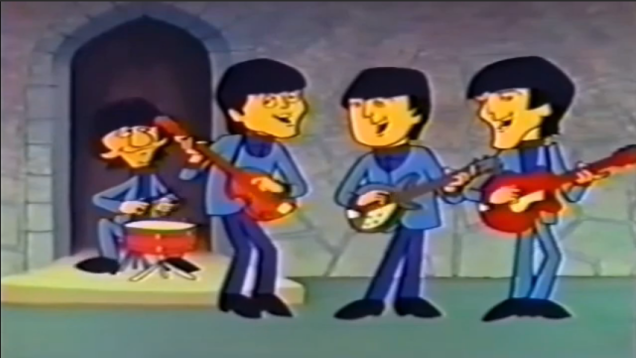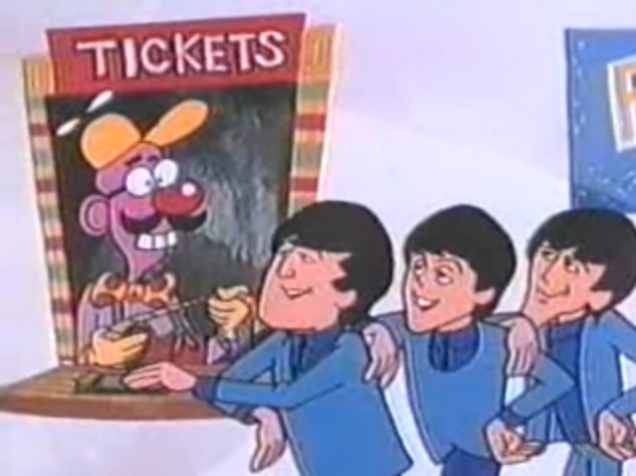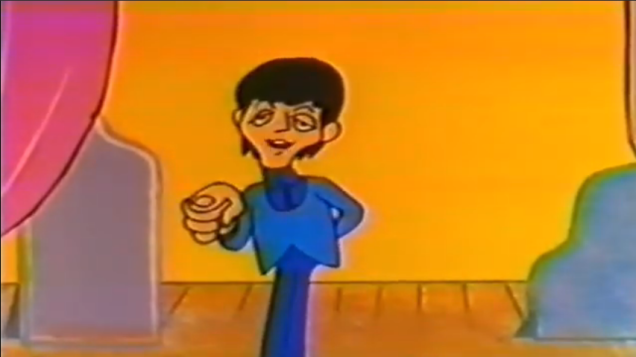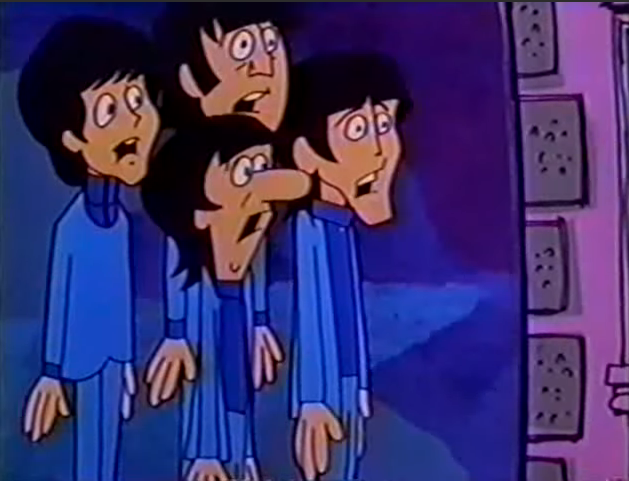
When I’ve written about bad cartoons, I’ve mostly focused on ones from eighties and nineties, if only because they are part of (or at least close to) “my” time, and so I have more familiarity with their specific context and methods. However, cheaply-made television animation is not a phenomenon of a single era, and in fact has been there from the very beginning—and as poor as later shows are, they often look positively gripping next to the Saturday morning dregs of the sixties and seventies. For every show that managed to inject some cleverness into even the stiffest of animation, like Rocky & Bullwinkle, there were a dozen or more that barely qualify as entertainment. These shows are often so alien to my sensibilities as someone who grew up in the nineties and beyond (even though I lived in a time when they’d still be rerun on TV occasionally), they become fascinating—how did kids of previous generations find this passable? I guess it shows the power wielded by television, or cartoons…or maybe just low standards.
Aside from formulaic and low-effort cartoons, the sixties were home to other youth-based cultural trends, such as that whole rock music business. Who was among the chief proprietors of popular rock-and/or-roll music at the time? It was a foursome from Liverpool who called themselves The Beatles. It’s possible you’ve heard of them. At the height of their popularity, they had a formulaic and low-effort cartoon made to cash in on their fame—and it is well-documented that the band hated it (although later, some of them could come to appreciate the novelty of having a bad cartoon counterpart.) The existence of The Beatles, which ran from 1965 to 1967 (so, basically, when the real band was transitioning from skilfully-made pop songs to more experimental stuff like Revolver), is interesting in both a historical way and also a Bad Cartoon Watching way: how did they take this group of real people, with a particular image, and turn them into cartoon characters? About how you’d expect—but the juxtaposition sure is something to see.

Let’s get the obvious things out of the way: The Beatles did not provide their own voices, and while Englishman Lance Percival is not distracting or weird as Paul McCartney and Ringo Starr, the legendary Paul Frees (Boris Badenov himself, who also provides the voices of about ninety percent of the other characters on this show) as John Lennon and George Harrison is infamous for just how off he is. Frees’ John has the air of an American trying really hard to sound British, and his George seems to be trying to do a Scottish, Irish, and possibly Welsh accent all at the same time. One should not go into a sixties Beatles cartoon expecting them to sound much like their real selves, but even so, the fact that Frees apparently didn’t try to be even remotely close starts the whole endeavour on a campy note.

Their personalities are a much more complex matter, considering that between how they were portrayed by their publicists, how they portrayed themselves in movies like A Hard Day’s Night, and maybe possibly who they actually were as people, there’s a bit of room for interpretation. I’m sure we all have versions of Paul, John, George, and Ringo that exists only in our own minds. In the minds of the people behind this show, John and Paul share the lead role (as they did in real life), with the former as the bolder one who concocts schemes (sort of the Alvin to their Chipmunks, a comparison that is insulting, but also probably how the cartoon’s producers thought of it as well) and the latter being nicer and more laid back. I could see cartoon John also making the “More popular than Jesus” comment, but I feel that the sloppy, inconsistent animation frequently exaggerates Paul’s distinctive look into an unflattering half-lidded daze. Ringo ends up being the butt of most of the jokes, a comically inept bumbler who loves puns and is constantly insulted by the other band members (he is also given an annoying laugh, and seems noticeably absent from many of the musical performance sequences)—this follows a trend in how the world at large regarded poor Ringo (although at least in Yellow Submarine he is portrayed as more sweetly naïve), and I wonder how he felt about people looking at him and saying “Yeah, he’s the dumb one.” Meanwhile, George is…there. One time, he built a robot. Considering that George Harrison actually was a pretty interesting person, this feels like giving him short shrift. On the other hand, even after saying all that, it’s not like any of them are really big personalities with a lot to differentiate their actions—the fact that the Wikipedia entry describes all of them as having a “dry wit” says it all.

Also, we have to remember that the show was airing when the band was making some major changes to their output, mostly leaving their teen idol days behind—but for various reasons, the show didn’t change along with them, freezing their looks in their early sixties incarnations. That’s another interesting context thing: it was a show about The Beatles that wasn’t even up to date with where The Beatles were in their careers. The only nod to how their looks changed in the meantime was in the intro, which would later include photos of them with their Sgt. Pepper’s era moustaches.

That’s three paragraphs about the Beatles themselves, but what about the actual cartoons? Honestly, how the show portrays the Beatles is probably the most interesting part of the it, because if you’ve seen one sixties gag cartoon, you’ve already watched this one. Same type of bad jokes, endless chase sequences, repeated animation cycles, actually pretty beautiful hand-painted backgrounds, and slight Bullwinkle-style meta humour (in one episode, they tell to the narrator to stop giving away their hiding places, for example)—the only things that real make this feel like it’s about a popular rock band is the recurring gag about the mobs of screaming young women running after them. Yes, they do rehearsals and talk about going to gigs, and the segments would try some way to take the title of one of their songs literally, but that’s all just a pretense to get them into a haunted house or something. Most of the “stories” aren’t even weird enough to be notable—the Beatles go to a place, and then play a song while some very light action is taking place. The most bizarre segment had the band members show off their hobbies, which in Ringo’s case is collecting “birds”, which means he’s keeping a woman in a cage until someone justifiably lets her out, leading to chase scored to “Ticket to Ride” (I feel like the producers thought these newfangled British slang terms were the height of comedy)—or maybe it’s the one where a woman pretends to be a vampire so she can trick Paul into marrying her, or maybe when Ringo falls in love with the mirror image of himself wearing a wig. I did manage to mostly avoid episodes that dealt in what I am charitably going to call “ethnic humour”, which was disconcertingly rampant in cartoons at the time—but don’t worry, there’s around twenty episodes I didn’t watch, so there could still be plenty there.

If one thing impressed me while I watched these segments, it was how little actual content they were able to get away with. In each five-minute cartoon, around half would be taken up by them animating over a song (so, at least you get good music), removing the need for additional writing and voice acting—and in between each episode’s two shorts, there would be a “sing-along” segment where they would play two more songs with words on the screen, which translates to even less actual animation (although the songs were introduced by Ringo and another Beatle in a way that once again reminds me of Rocky & Bullwinkle, and also included Paul condescendingly telling kids who had trouble following to just say “yeah yeah yeah.”) Backed by the rights to a veritable musical gold mine, the producers of the show could basically do the bare minimum and still attract an audience (I mean, there are episodes that have worse animation than normal, which is mind-bending to contemplate)—it’s the perfect scam, and another example of how low the TV cartoon baseline was that early on its history.
There were many nearly identical laff-free cartoons like this made at the time, but The Beatles has continued to have a cult fascination solely based on, well, being about The Beatles. It must be among the most cynical attempts to cash in on the band’s fame, but that just makes its weird place in their wide, eclectic oeuvre a little more notable, adding to the “I can’t believe that happened” factor. The Beatles were a big enough enterprise that they could have poorly-animated cartoon versions of themselves running around on TV barely amusing kids while still making great albums, and the baffling contrast kinda justifies the show’s creation—as a cartoon it offers little more than another excuse to listen to hit music, and the mere fact of its existence is by far the most interesting thing about it.
BUT, IS THE THEME SONG CATCHY?: Depending on the season, the theme song was “Can’t Buy Me Love”, “Help!”, or “And Your Bird Can Sing”—so, yeah, I’d say so.
